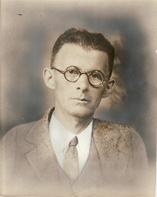
1920 Philately was becoming the modern hobby it is today. By 1920, Maurice Apfelbaum had been a stamp dealer for over ten years and Earl was 15 years old and a confirmed stamp collector. Collectors were beginning to specialize. Maurice, who had structured his stamp business selling at stamp clubs and bourses, put out his first printed price list in 1921. It was for US revenue stamps. Cover collecting was gaining in popularity. King George V, perhaps the world’s most prominent philatelist, was on the throne in Great Britain. New issues were proliferating. In the two decades to 1930, changes in British Empire watermarks and the increase in independent postal administrations produced by WWI more than tripled the number of collectible stamp varieties. Philately was now a major hobby.
1930 Earl opened his first retail shop in 1930 not long after the stock market crash of 1929. At first, it appeared that the crash would not extend to the general economy. But then the liquidity crisis swept through the banks and many failed. No government bank insurance existed and as banks failed, people’s savings disappeared with them. Soon the economy was cascading in free fall. Stamp collecting suffered too. But our hobby can exist at all levels. When rarities can’t be purchased one can always collect precancels or perfins both of which inexpensive specialties became very popular in the 1930s and allowed the search for thousands of varieties at very little cost. And the rank of unemployed and underemployed created a pool of thousands of stamp dealers who hoped to augment their income with a little stamp dealing. H E Harris sponsored Captain Tim’s stamp club and even though the dollar volume may not have been as great as in the previous decade, our hobby had never been more popular.
1940 The decade of 1940 was dominated by World War II. Life on the home front during the war was tough. Rationing meant that impulse purchasing of most items was out. Gasoline was rationed, as were most items. The minimum ration for someone who did not use their automobile for employment was two gallons of gas per week. In an era when cars got under ten miles to the gallon this did not take you very far. But factories and business were operating full tilt. Unemployment was nonexistent. So people had large amounts of money and not much to spend it on . Wage and Price controls existed on most things but not on Stamps. You can guess the rest. A war induced boom pushed stamp prices very high and a lack of mobility created many stay at home collectors.
1950 As the decade of 1950 began, the Apfelbaum family celebrated its fortieth year of professional stamp dealing. Though stamp collecting had always been popular in the United States, the hobby had never had the influence here that it had in Europe, especially in Germany and Central Europe. In Germany stamp collecting had the popularity that football or American Idol has here. Large stamp expositions attracted hundreds of thousands of people. After WW II the central European economies were in shambles. Industry was all but destroyed. Huge quantities of classic European stamps were exported to the US to help their owners buy food and clothing. Apfelbaum, which had always been a worldwide stamp house, began to import collections from Europe and by the end of the decade was one of the largest sellers in the US of worldwide stamps.
1960 Stamp collecting entered its most transformative years in the 1960s. As the European economies recovered from WW II devastation, huge demand dramatically drove up the prices of countless stamps that had been purchased only a few years before as new issues but which could not be afforded by European collectors at the time. Many collectors made enormous profits on their stamps. Savvy philatelists had always known that stamps could be a good investment, but now that realization was reaching a wider audience outside our hobby. Quality standards changed as well. A presentable looking stamp was no longer enough. Stamps now had to be perfect and never hinged. The baby boom generation began their collecting life and they were introduced to such nontraditional philatelic items as plate blocks and First Day Covers in great numbers.
1970 Price inflation was the defining event of the 1970’s both in the worldwide economy at large and in stamp collecting. In 1971 the system of fixed currency exchange rates that had been set up at Breton Woods after WW II was ended. Currencies were allowed to “float” – that is rise and fall against each other in response to market demand. After 1971, for the next ten years, most of float was against the dollar with our currency losing nearly 50% of its value against the German mark by the end of the decade. Since most stamp demand was again German, this increased prices of philatelic material dramatically. Further the oil shocks of the early 1970’s and the double digit inflation of the1975-1980 period increased prices of stamps nearly threefold during the decade.
